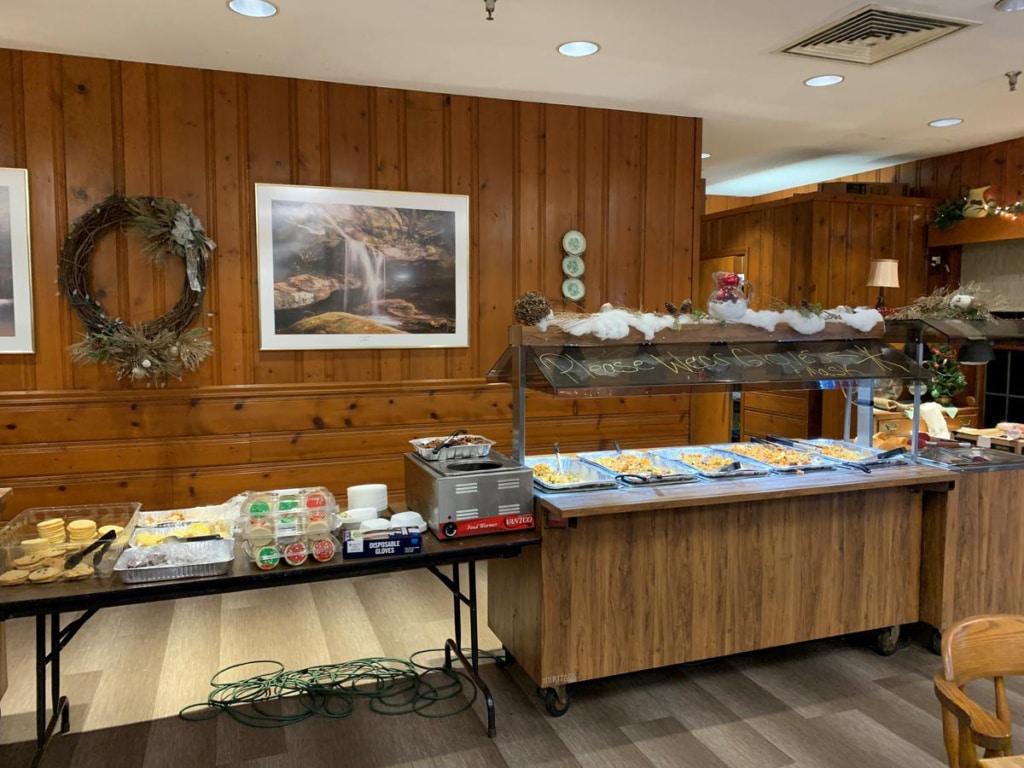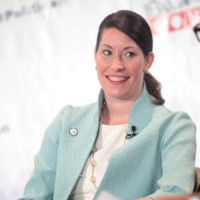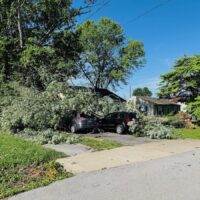David Gray and his family were in their mobile home when December’s deadly tornado outbreak hit Dawson Springs.
The home rolled more than two times, pinning Gray’s wife and one of his daughters. He spent nearly 10 minutes digging his daughter out after the tornado passed, using the brief flashes of lightning strikes to find his way around.
“Everything was gone,” Gray said. “And it was so loud, too. It was crazy.”
The family went to stay with Gray’s daughter for the first month after the tornado. Eventually, the daughter’s landlord said the family had to leave, and they arrived at Pennyrile Forest State Park, still trying to figure out what would be next.
Gray, a work planner at a tree company, said staying in Pennyrile has been a little hectic. Though a bus stops at the lodge every school day, the family is still overloaded trying to process the disaster.
“We don’t have to take the kids up to school, but we do because most of the time, we’re so tired because we run … (we’re) just – we oversleep and everything else – running half the night just trying to get this and that done.”
•••
The Gray family’s Pennyrile stay isn’t unique. There are 28 other rooms at the state park housing tornado survivors.
In total, 105 rooms are being used at five Kentucky state parks – Pennyrile, Kentucky Dam Village, Kenlake State Resort Park, Lake Barkley State Resort Park and Barren River Lake State Resort Park – to house tornado survivors currently, according to State Parks Commissioner Russell Meyer. Tornado survivors have also been housed at Rough River Dam State Resort Park and John James Audubon State Park. In a Feb. 14 press release, Gov. Andy Beshear said 243 people are being housed at the state parks. The same press release also said that the parks will soon consolidate the number of parks providing housing to tornado survivors.

Some of the consolidation efforts will include moving more families into medium-term housing through the Commonwealth Sheltering Program and trailers from the Federal Emergency Management Agency.
“What we will do is we will open our parks back up (to the public) and move the displaced families more into a one-park area while the FEMA transition is going on,” Meyer said.
The plan to consolidate families to fewer parks isn’t “set in stone,” Meyer said, but as the state parks work with FEMA on that plan, they will let people know.
•••
Gray and his family have been looking for a new place to live outside of Pennyrile, but that process has been a difficult one so far. They’d been staying at their previous home for the past seven years and their landlord didn’t want them to build a new home on the property. The family could, however, put down another mobile home, but says he doesn’t want to do that.
“My youngest daughter, she don’t want to move,” Gray said. “Everytime she hears the word trailer, it freaks her out. She cries ‘No, Daddy, I don’t wanna live in a trailer’ and that’s kind of hard.”
Before the tornado outbreak, there was already an affordable housing shortage. People were struggling to find homes. After the tornado, the housing shortage has gotten worse in western Kentucky.
Donna Miller, a retiree from Dawson Springs, hopes to get out of Pennyrile and into a new home soon. She’s hoping for a new trailer to put on her property sometime in the next month.
“There was so many people displaced in Dawson,” Miller said. “I have no idea. I don’t really think there’s any apartments available down there but I will certainly look if I don’t get my trailer soon.”
Miller’s lived in Dawson Springs for the last 18 years and she wants to go back. The tornado left her without a home and she suffered a concussion that put her in the hospital for several weeks. She only started staying in Pennyrile in the last two weeks, after her release from the hospital.
Both Miller and Gray want to be out of Pennyrile before tourism season starts up in April.
•••
Seven years of historical occupancy data from the Cabinet of Tourism, Arts and Heritage shows that across the seven state parks tornado survivors are or were housed in, tourism season runs from April to October. Occupancy rates are significantly higher during these months and generally peak in July.
Meyer said tourism season will not impact the state parks’ decisions and plans for housing tornado survivors.
“We’re housing the tornado survivors that were impacted,” Meyer said. “These people lost their homes. They’re in need of help, and we’re here to help.”
Since the tornado outbreak, Kentucky State Parks has given tornado survivors more than 17,400 more nights. Kentucky Dam Village and Pennyrile have used the most room nights at about 6,000 each. Kenlake and Lake Barkley have used the next most room nights at about 2,700 each.
Taking the average revenue per available room for the parks used for tornado survivors for the past seven years – $40 – and applying that to the amount of room nights survivors have spent in Kentucky state parks, the Commonwealth has spent around $696,000 so far housing displaced tornado victims. Meyer said there will be a report to FEMA about the cost of housing people in the state parks to recoup those funds.
He doesn’t know when people will start moving out of the parks.
Meyer was in Dawson Springs in the days after the tornado and saw the devastation it had caused. He said the state parks are here to take care of the people impacted by this disaster.
The handoff from parks doing the majority of the work comes when FEMA takes over and provides trailers, but state parks will still be involved since trailers will need to be housed at their campgrounds.
Storm victims and the state are both trying to figure out the logistics of this process step-by-step along the way.
“We’re learning as we go,” Meyer said. “There’s no playbook for this.”
Lily Burris is a features reporter for WKMS. She has a bachelor's degree in journalism from Western Kentucky University. She has written for the College Heights Herald at WKU, interned with Louisville Public Media, served as a tornado recovery reporter with WKMS and most recently worked as a journalist with the Kentucky Center for Investigative Reporting. In her free time, she enjoys reading, crocheting and baking.





